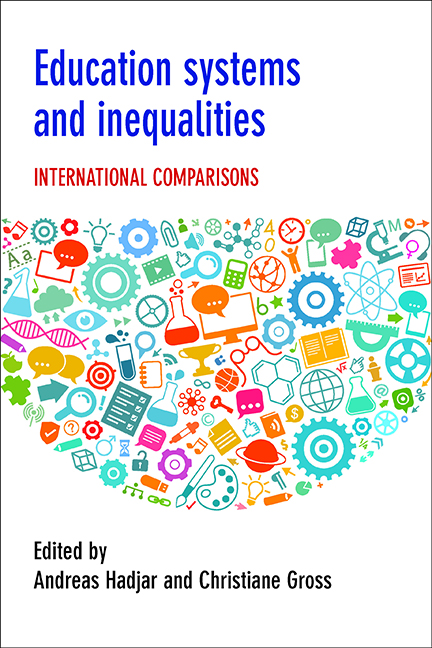Book contents
- Frontmatter
- Contents
- List of tables and figures
- Notes on contributors
- Acknowledgements
- Introduction: education systems and inequalities
- one Theorising the impact of education systems on inequalities
- two Comparing education policies in a globalising world: methodological reflections
- three Education systems and intersectionality
- four Measuring educational institutional diversity: tracking, vocational orientation and standardisation
- five Sorting and (much) more: prior ability, school effects and the impact of ability tracking on educational inequalities in achievement
- six Data analysis techniques to model the effects of education systems on educational inequalities
- seven Education systems and inequality based on social origins: the impact of school expansion and design
- eight Education systems and gender inequalities in educational attainment
- nine Tracking, school entrance requirements and the educational performance of migrant students
- ten From exclusion and segregation to inclusion? Dis/ability-based inequalities in the education systems of Germany and Nigeria
- eleven Education systems and meritocracy: social origin, educational and status attainment
- twelve Education systems and gender inequalities in educational returns
- thirteen Education systems and migrant-specific labour market returns
- fourteen Health returns on education and educational systems
- fifteen Good and bad education systems: is there an ideal?
- Conclusions and summary
- Index
six - Data analysis techniques to model the effects of education systems on educational inequalities
Published online by Cambridge University Press: 05 April 2022
- Frontmatter
- Contents
- List of tables and figures
- Notes on contributors
- Acknowledgements
- Introduction: education systems and inequalities
- one Theorising the impact of education systems on inequalities
- two Comparing education policies in a globalising world: methodological reflections
- three Education systems and intersectionality
- four Measuring educational institutional diversity: tracking, vocational orientation and standardisation
- five Sorting and (much) more: prior ability, school effects and the impact of ability tracking on educational inequalities in achievement
- six Data analysis techniques to model the effects of education systems on educational inequalities
- seven Education systems and inequality based on social origins: the impact of school expansion and design
- eight Education systems and gender inequalities in educational attainment
- nine Tracking, school entrance requirements and the educational performance of migrant students
- ten From exclusion and segregation to inclusion? Dis/ability-based inequalities in the education systems of Germany and Nigeria
- eleven Education systems and meritocracy: social origin, educational and status attainment
- twelve Education systems and gender inequalities in educational returns
- thirteen Education systems and migrant-specific labour market returns
- fourteen Health returns on education and educational systems
- fifteen Good and bad education systems: is there an ideal?
- Conclusions and summary
- Index
Summary
Introduction
Examining the impact of education systems on educational inequalities raises several methodological questions. The first main question concerns the choice between two general research strategies: the comparative approach and the multi-level approach.
The comparative approach (CA) involves studies that consider only a few countries and compare both the characteristics of the education system and educational inequalities in the outcome dimension, such as competencies and educational credentials. This strategy allows for a detailed presentation and analysis of the education systems involved and is delineated in the next section.
The multi-level approach (MLA) involves studies that analyse data at multiple hierarchical levels: country, school, class and individual. Usually, the data analysed is provided in the form of large-scale surveys, such as the Programme for International Student Assessment (PISA) or the Programme for the International Assessment of Adult Competencies (PIAAC). These surveys include data from numerous countries, as multi-level analysis requires a certain number of macro-units. As a result, the analysis is restricted to those characteristics of education systems that are available for all countries involved – or at least most of them (see Bol and van de Werfhorst, this volume). Conducting multi-level analysis requires some further understanding of econometrics and raises some issues that are discussed in in the third section.
The first alternative under consideration (CA) allows us to provide an in-depth description of each education system, and the second alternative (MLA) serves as a strategy for determining significant effects while using sketchy variables to describe education systems in a standardised manner.
Comparative approaches
The CA typically includes small-N studies or case studies, and medium-N studies that have been recently analysed by qualitative comparative analysis (QCA). Performing a comparative analysis with a few countries requires two main decisions: which countries should be included and which methods should be applied? These questions are deeply confounded as will be shown next. I will start with (a) classical comparative methods and modern conjunctions with small-Ns or two-country-comparisons, move on to (b) QCA and medium-N studies, and show (c) a possible means of combining case studies with quantitative methodologies.
(a) Classical comparative methods are based on the work of Mill (2014 [1843]) who distinguishes the method of difference and the method of agreement. According to both methods, the decision of which countries to consider should be derived from causality arguments.
- Type
- Chapter
- Information
- Education Systems and InequalitiesInternational Comparisons, pp. 115 - 134Publisher: Bristol University PressPrint publication year: 2016



